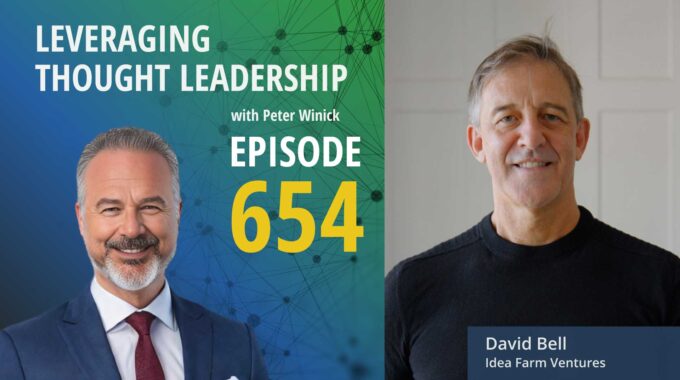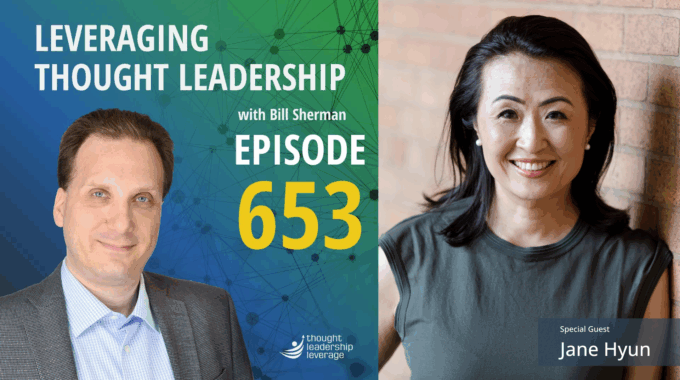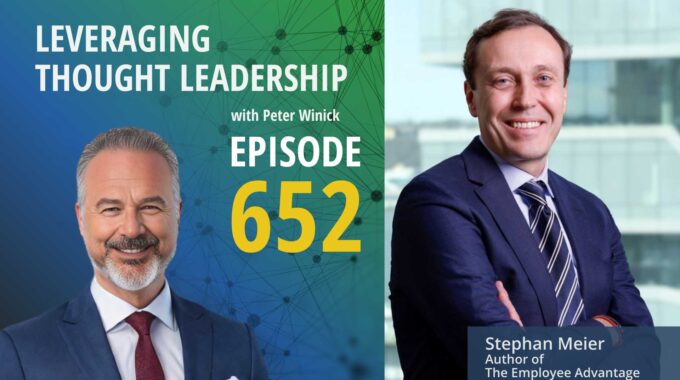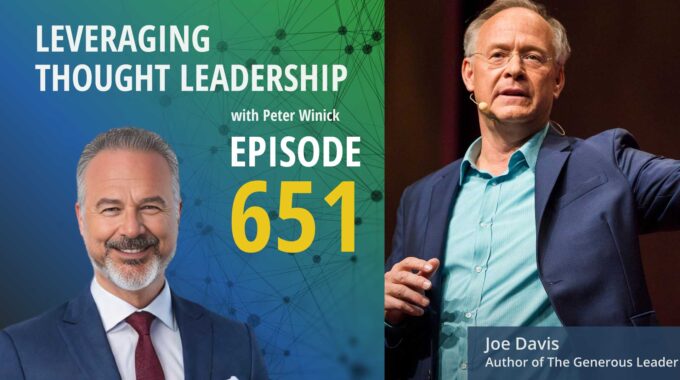Turning frameworks into funding: The hard truth about scaling thought leadership. This episode explores how…
Growing a Leadership Development Firm | Vaughn Sigmon
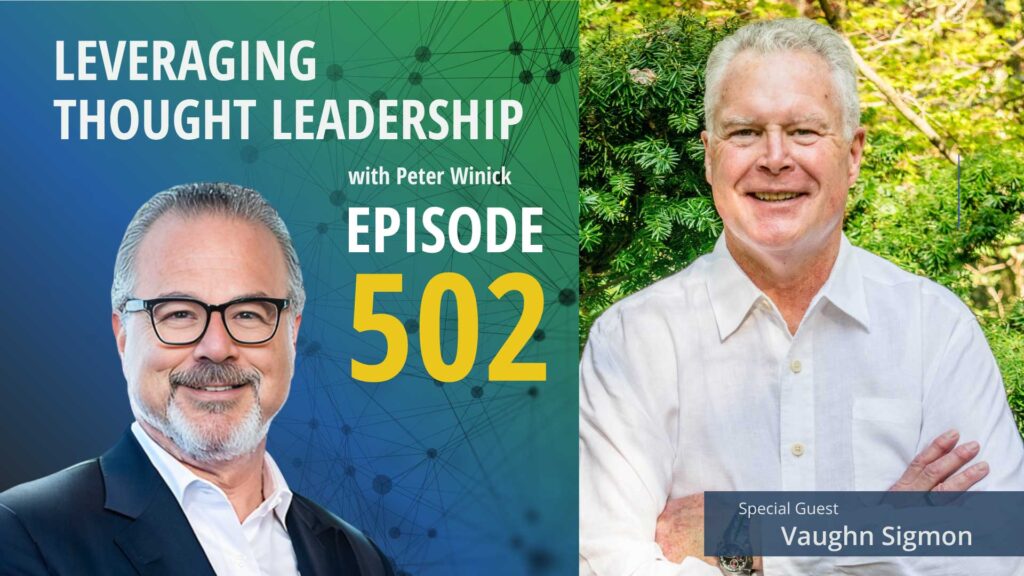
Building the right platform to engage with your audience.
An interview with Vaughn Sigmon about the methods he uses to break into an overpopulated space and find success.
Thought leaders have a passion for ideas, frameworks, and methodologies.
But many struggle with defining their brand, finding clients, and maintaining a stable revenue stream.
Don’t worry – help is on the way!
Today, we’re talking with Vaughn Sigmon, the co-founder of Results Driven Leadership which specializes in helping businesses unlock their full potential through transformative leadership practices. Vaughn is also the host of The Business Mechanic – where he shares his expertise to improve the impact of executives and managers by enhancing their knowledge, skills, and abilities.
Leaving a stable executive position to start his own leadership development business was a huge risk. We talk with Vaughn about the driving force behind his shift in career and why he chose the area he did.
Leadership development is a crowded space to enter. Vaughn shares what he did to stand out and win clients. Acquiring clients is the hardest part that few want to talk about. We learn how it requires a multi-step marketing process that creates multiple touch points, allowing potential clients to get to know you, what you stand for, and the problems you are able to solve.
Vaughn explains how the two main marketing platforms he has been using are LinkedIn and podcasting. We learn how Vaughn became smart and focused on who his audience would be and how to create awareness, interest, and a relationship with your audience on the platform.
Finally, we learn about the advantages of starting a podcast or doing the circuit as a guest. Plus, he shares tips for getting your audience to engage and move further down the sales funnel.
Three Key Takeaways:
- You need to get in front of the right people, so they get to know you. If they don’t buy who you are they’re not going to buy your concepts.
- If you are smart and focused, your message is on point, LinkedIn can be a gold mine.
- The title of a podcast or blog entry is of utmost importance. Having great content won’t matter if no one reads it because the title does not entice them.
If you need a strategy to bring your thought leadership to market, Thought Leadership Leverage can assist you! Contact us for more information. In addition, we can help you implement marketing, research, and sales. Let us help you so you can devote yourself to what you do best.

Transcript
Peter Winick And welcome, welcome, welcome. This is Peter Winnick. I’m the founder and CEO at Vault Leadership Leverage and you’re joining us on the podcast today, which is Leveraging Thought Leadership. Today, my guest is Vaughn Sigmon. Vaughn is the co-founder of Results Driven Leadership. He’s a leadership development expert, a podcaster and an author. He’s worked with hundreds of businesses, helping them deploy his programs and advice. He’s a former executive at CarMax, and CarMax is obviously a pretty well respected company in the auto industry and was considered a Fortune 100 best places to work. So without further ado, welcome. Thanks for coming on board today, Vaughn.
Vaughn Sigmon It’s a pleasure to be here, Peter. Thanks for inviting me.
Peter Winick So tell me a little bit. I’m going to go in a little bit of a different direction for a couple of moments. So you’re in a leadership position at CarMax, right? Right. Company, hot industry, kind of revolutionary, etc., etc.. And then you’ve transitioned into sort of the leadership development space. So we work with a lot of folks that do that, that transition from, you know, whether it’s a CEO or leadership position, founder or whatever, what was underneath that, What was calling you to say, wow, this is really I don’t want to be helping people buy and sell cars, but I really want to help leaders develop themselves.
Vaughn Sigmon Yeah, good question. And so there is a progression. With every company as it as it grows Metamorphoses. And changes. And I knew the day was going to come at CarMax, as it does with most major organizations wrestling retail, which is primarily my background. When I joined CarMax, they had 12 locations.
Peter Winick Right?
Vaughn Sigmon By the time I retired from CarMax, they had close to 200 locations. One of the things I often said about my love for CarMax is they allowed me to be an entrepreneur in a very highly corporate environment.
Peter Winick Sure.
Vaughn Sigmon We were making it up. We were building it and creating the business for those first ten years. I was with them, but I also knew there was a point of saturation that we went from creating to pure execution, running it yet by a checklist. And that bores the snot out of me. And so when that moment came, I suffered through it for about a year and I said, Enough, this is boring. I don’t like doing it right. But you bet. And then I said, I’m going to go create my own thing.
Peter Winick So that so that’s a villain thing where you’re a growth guy, not a manage it and make the 217th unit look like the 200th. And I get that that’s sort of the. The difference between leadership management or the fact whatever. But you could have easily taken another role in another high growth company in retail. Yet you chose to launch your own sort of leadership development organization. So that’s kind of what why that as opposed to what you’ve been in for so long.
Vaughn Sigmon After 40 years of having a boss? Peter I was done having offices. I had a lot of good ones. I, at the ripe old age of 56, was done with working for a big corporation and having a boss. I wanted to be my own boss. I wanted to do only what I wanted to do around my passion, which is what I do. And it was escaping that whole concept of the corporate hierarchy.
Peter Winick So oftentimes when people go out on their own, that’s one of the reasons they say, I want to be my own boss. But the reality is now you’ve got lots of bosses, your employees, your customers, right? It’s not it’s not like the best of both worlds is you automatically get a paycheck every two weeks and you don’t do work thing and you don’t have a boss. You have different responsibilities. And I think there’s a difference in being a practitioner of leadership development and an entrepreneur in that space, which is incredibly crowded, right? Once you start getting into the weeds there, you’re like, Wow, everybody’s in the leadership development business. So what are the things that you’ve done from a sales, marketing, branding, differentiation perspective to get the clients? Because that’s kind of the hard part.
Vaughn Sigmon Well, it is the very hardest part that nobody tells you about, right? It’s all these concepts of having your own business are beautiful until you have to have somebody buy it. And so, as you know, I’m very much I learn by mistake or learn by experienced person, which I think many people are. I have a very high-risk tolerance. And I taught myself, I took a lot of courses. I followed other and copied other people who were building their business. And I found a way to go get clients, which is always a multiple step marketing process. But you have to be doing a lot, a lot of things and you’re going to get a little from a lot of things.
Peter Winick Which So let’s unpack that a little bit because I think all too often and I’m not diminishing or discounting the value of high quality thought leadership, high quality intellectual property, but where most folks in your space struggle most is not coming up with ideas, methods, frameworks, methodologies, You know, they don’t have to fake the passion, but it’s like, okay, how do I develop my brand? How do I find clients? How do I consistently keep revenue consistent so it doesn’t look like the EKG of a coronary patient? Stay there for a little bit with me. Like what was your learning curve there and what’s worked for you and what hasn’t.
Vaughn Sigmon So through some trial and error, identify the elements of marketing that work for me. LinkedIn making LinkedIn connections, having conversations, marketing to two CEOs on LinkedIn. Creating a podcast. Creating a blog. Being consistent with all of those. That’s that right there. Peter is the hardest thing for most people. It was for me in speaking with many others. It’s just being consistent with it, working the process until the process works because there’s no instant gratification in any of this. It takes time. It takes sticking with it. It’s eating a lot, a lot of dirt until it starts flowing. And so it was it was finding lean, too, and learning how to utilize a podcast and a blog. A newsletter.
Peter Winick Well, let’s break this down.
Vaughn Sigmon You know, etc., etc., etc.. Get in front of the right people so they would get to know me. They going to buy me. They’re not going to buy my leadership concept. They’re going to believe that I can bring to them the solutions they’re looking for. It’s them understanding.
Peter Winick Me. Yeah. So let’s individually, if we could unpack a couple of those tactics. So when we talk about LinkedIn and I think you broke this down nicely. Well, step one, you have to make connections. Well, in order to make connections, you have to have real a real clarity, a real definition around to whom, right? Who the buyers who are the avatars. Shockingly, to me, a lot of people are saying, look who’s the buyer? I get all sorts of stuff. And if you can’t be specific and articulate that well, a LinkedIn just got lots and lots and lots of people. So how did you sort of hone in on the buyer persona or the avatar for you?
Vaughn Sigmon It was really painful to go through.
Peter Winick Peter Oh, that doesn’t sound like 500 people.
Vaughn Sigmon So yeah, and I spent money on it. I hired two coaches, one a branding coach and one a LinkedIn coach, someone who was an expert on LinkedIn. So I work with my branding coach. Liz. Liz helped me go through the painful process of identifying and. Arrowing down who your target market target customer is. And there was a lot of questions. It was multiple meetings. It was a lot of frustration on my part because I wanted to be everything to everybody. I didn’t want to leave a single dime on the table and Liz forced me into the area that I ended up being very focused on certain sized companies, certain industries. Zaxby’s Right. Certain needs within those companies have been defined and turn that into words that are attractive to people. Then I hired a John who was my LinkedIn coach. You know, Liz was about ten grand. John was about 15 grand, but he gave me the.
Peter Winick Tools.
Vaughn Sigmon And materials I needed and the mindset he gave me the.
Peter Winick Other minute. So, Liz, Liz, is a value prop to you is this is the Who. And now, John, I think you said your name was is the what? Okay. Now on LinkedIn, here’s the mechanics of how to create a campaign. How many touch points, how to send it out, how to follow it up? And you know, what I find almost comical is people dismiss the whole process. Oh, I don’t you know, LinkedIn is not for me. It’s not for me. It’s not for me. There’s 800 million buyers on LinkedIn. Right. And I think it’s all about getting over yourself, getting out of your comfort zone, and then supporting yourself with the right systems and processes and methodologies. Nobody wants to be that guy or gal, Mr. or Mrs. Spammy on LinkedIn. And I think the reason some of us get a little fringy when it comes to LinkedIn is because there are a lot of sloppy, lazy marketers that, you know, and you probably I’m sure you get these as well born every day. Oh hey, we can be your app developer. I don’t develop apps. We could be your whatever, whatever. I don’t you know, we could be your solar roof panel people, whatever. But if you’re smart and you’re focused and your message is on point, LinkedIn is a goldmine. So I’m assuming your ultimate objective with LinkedIn is to get a potential prospect to get on a phone call and just have a conversation, right.
Vaughn Sigmon That that’s the advancement of the that the sale right It’s the deal stages. Yeah and you got to create interest. You’ve got to get awareness. You got to create interest. You got to have a connection and engage with them. It’s the classic funnel. Yep. And it’s just doing it and figuring out how many touchpoints you have to make in order to get there and understanding to not everybody need you. You’re going to get it ignored a lot. But I found out, you know, and I’m a big data guy, if I send out 2500 LinkedIn messages for every 2500 messages, I’ll get a client.
Peter Winick Okay? All right. And you just do the math backwards and say.
Vaughn Sigmon It’s 2500 messages.
Peter Winick Okay. So now if you stay there, you’ve got a clear sense of your customer acquisition cost. So 2500 cost x x equals a number that you’re comfortable spending to acquire a client for the first engagement, because then you don’t have to spend that money again for engagement two, three and four. Cool. I love it. Thank you for the LinkedIn piece.
Peter Winick If you’re enjoying this episode of Thought leadership leverage, please make sure to subscribe. If you’d like to help spread the word about our podcast, please leave a five-star review at ratethispodcast.com/ltl and share it with your friends. We’re available on Apple Podcasts and on all major listening apps as well as at thought leadership leverage.com/podcast.
Peter Winick I want to I want to pivot now to podcasting because most people I shouldn’t say most many people like to be a guest on a podcast or even a host on a podcast, but they don’t necessarily have a very clear or well thought through business strategy. So to me, let’s take the guest piece Reasons to be a guest on a podcast. Again, it’s got to be the right podcast based on your avatars, right? It’s you can elevate the brand, you’re creating content and assets that can be repurposed seven ways still Sunday, right? Like all the content that you do and somebody else, i.e. the podcast host has done the hard work, which is they’ve got an audience that you’re going to borrow for a few moments and engage with for a few moments. And the hope is that some subset of those people reach out. And I think the hard thing about podcasting as a guest is that it’s hard to get the exact number. Oh, I did ten podcasts last month and nothing happened. You know, you really have to commit to doing X number of months for a specific period of time, and then there’s a compounding effect of all of a sudden you get a lead from a podcast you did a year and a half ago that’s not even on your mind. So is that is that aligned with your experience?
Vaughn Sigmon Yeah, it was. It was again, a big learning curve. And it’s one thing to do a podcast, it’s another thing to be able to utilize that in a marketing approach that actually works. And one, it’s back to that consistency. You have to put the content out. Or every week. You have to be consistent with the content along with your keywords, your tags, to make sure that people are going to find you. And in the searches to listen to you, then you have to deliver content that is engaging and valuable to where they continue to grow as an audience participant. And within each podcast, you need to make an offer. That’s the one I missed out on for the first couple of years, is giving them something to engage further with me, to take them further down the funnel is that, Hey, I’ll give you a three disc assessment. This is a is a is a valuable tool. I try to work that into almost every one of my podcasts because I am a true believer in the value of that. Here’s a free disc, here’s a free download, here’s a pre this, here’s a pre that to get them engaged now which. Peter, I hope I’m not giving away too many secrets to the audience, but it’s now I’ve got their email, right? If I’ve got their email now, I can talk to them directly in a different format through a newsletter, through Gravenhurst. I can take them through other parts of my marketing console.
Peter Winick I find that. So I love that. I find that as a pub, you know, when people are listening to podcasts, unlike if I’m on LinkedIn and I want to learn more, click here next. If you know anywhere else, if I’m in front of my device and I want to learn more, sign up for news, like it’s really conducive to that. I think one of the issues with podcast is the use case is usually the car, right? So people you know and people don’t remember a lot like you’re driving this that you know, email via an ad blah blah blah or the gym where you’re on the treadmill sweating like a pig is going to stop. So how do you break through that? I mean, is it in the shit? Like where I just find that’s just part of the I don’t know, whatever the rhythm of a podcast is. Wait, how are people actually listen? Because they’re not sitting there with a pen and paper taking notes typically.
Vaughn Sigmon Yeah. And you’ve got to make it easy for them to go to those show notes and you have to tell them at the top of the show notes there is a link to your pre this and it has to be at the very top because you get about four sentences. Yeah. Where they get into read more and so I’ll put it at the very top. So it’s very and 90% of everybody listens is on a on a portable device an iPhone or other device and they can from writing the show notes at the very top, click on that link, enter their email and get whatever the asking for. So it’s part of the design. You have to make it easy and you have to talk about it in your podcast. You have to bring attention to it.
Peter Winick And do you have metrics that you use to gauge? You know, podcasts that have been a good use of your time versus not because there’s not I mean, the cost is, yes, there’s a cost to reach out, pick your podcast host or whatever your time, etc.. How do you consistently evaluate like these were the good ones and these were the not so good.
Vaughn Sigmon Once again, being a data guy, you know, I call my podcast, my podcast host, you know, there’s lips and lips and has a very good data platform. And if I go through and I look at all my most downloaded podcast in two ways, one, which one got the fastest download and the least number of days and which one consistently gets downloaded, what are the key elements that those have in common? And it’s always in the title and the titles leadership. It’s difficult people. It’s how to. It’s, you know, there are certain words that capture people’s attention in that title that brings them to listen to the podcast.
Peter Winick And I think I think that’s a critical concept because people think not all but many, that, wow, that was a great interview. And the point is, yes, maybe that interview A was better than interview B, but nobody knows that unless they listened. And they’re not going to listen unless they you know, that that that headline is catchy. And, you know, this is where, you know, we’re all working for the algorithm. We’re all working for the hashtag. You have to master these things because you could give the greatest interview that you ever gave. But if you put the wrong title, it’s going to get 5% of maybe one that was mediocre, that was tagged properly. And, you know, listen, life may not be fair. That’s just the facts, right?
Vaughn Sigmon 100% right. So, you know, again, you have to I well, I’ll put it this way. Many people in marketing will tell you whether it’s an email, a podcast, a blog, whatever it is, that the most important element is the subject line.
Peter Winick Right.
Vaughn Sigmon And you have to be able to design subject lines or titles that are designed in a way to capture people. And there are all kinds of tools out there including, yeah, that will do that for you. But you need to know what your key elements of words, leadership, difficulty, etc., etc., that you’ve got to build in there, that your API or your headline generator will be able to create for you. That is catching up to capture everyone.
Peter Winick And you also have to control the integrity of the brand because there are things when you do the research that say, Oh, if you did the seven secrets to, you know, what better lovemaking or whatever, you’re like, okay, yeah, maybe that’s going to get me to the top. But that’s not I’m point with my brand, so I’m not doing that right. So there’s always a tradeoff of, ooh, this would get more downloads, but you know, you don’t want to be clickbait. You don’t want to you know, you have to be you have to be proud and it has to be aligned with the integrity of your brand or you can do some damage there.
Vaughn Sigmon Absolutely. And it’s almost like going back to the exercise of your avatar for a prospective client. You have to have an avatar for a prospective listener. Yes. One of the topics they’re interested in and more importantly, how am I helping them? It’s not about helping me. How am I helping them? Because that’s where the value comes from. And so that’s where the content comes in. But if I lose people because I’m putting some B.S. in my in my title and then they listen. So that’s not what fawns about. That’s not what I want it to listen to. They’ll never listen to me again. And I lost a huge offer. Yeah, yeah, yeah. And so, yes, 100% Do I agree with you on brand integrity? You’ve got to deliver on whatever that title says. Yeah.
Peter Winick Exactly. So this has been phenomenal. I appreciate your willingness to sort of double click and go deep on the mechanics because I think that’s what folks need to do. And I think, you know, you’re a great example of it’s not why you even get in the business to master marketing, but you’re not going to stay in the business unless you figure out a book in your pieces.
Vaughn Sigmon And again, and there’s one other element I want to make sure I get through because I say this a lot and anybody, if they’re listening to start a business or want to grow their business, there is a statistic in sales that I think is critical for everybody to know because this has to work on your patients. 80% of your sales come after the 60 plus outreach.
Peter Winick Yeah. Oh, 1,000%. And here’s a yeah, I’m glad you brought that up because a lot of people said I tried LinkedIn. Well, tell me what you did. They made a connection and they sent one message. Dearborn, would you like to have a call with me? And nothing happened. So therefore they concluded LinkedIn is garbage. And it’s like, yeah, I mean, there’s various reports that say it’s five, six, ten, 12. So now those touch points don’t mean don’t be the person, you know, hitting me up three times a day. But it’s also multi integration, right? So it could be a combination of your newsletter, seeing you on a podcast, seeing you and you. No. When you’ve talked to someone that’s been exposed to a lot of your work, because when you’re speaking to them on a call, this has been my experience. They’re quoting you back to you. You know, they’re fluent in what you’re about. You know, they’re of the same mindset, You know, that, you know, they’re already sort of on third base as opposed to someone that’s coming in cold. You have to spend a lot of time educating them, which slows down the sales process.
Vaughn Sigmon And so at the end of the day, between two and podcast newsletters, it’s about, you know, 25%, 25%, 25%, 25%. Let’s not let’s not ever leave our client satisfaction because 100%. Yeah, yeah, because was that’s another marketing tool. You want to get referrals from your current clients, which I do a great job with and are my clients do a great job for me, I should say. But it’s all of those elements and it you’ve got to move on from a cold call to a warm call to and how do I do that? And that’s the consistency of the messaging, the value of the messaging over a long period of time. Back to my 2500 messages, that’s to about 150 prospects. That’s a lot of messages going to 150 prospects. But I do it over months and months and months.
Peter Winick Yeah, right, right.
Vaughn Sigmon Turn it on and turn it off. It’s got to always be good at it all.
Peter Winick It doesn’t.
Vaughn Sigmon Yeah, right. And that builds a consistently growing business.
Peter Winick Well, this has been great. I appreciate your time. I appreciate your willingness to share some of the what’s going on under the hood there. And I encourage folks to sort of process that and figure out how they can develop and implement a similar process that works for them. Thank you, Yvonne. Appreciate it.
Vaughn Sigmon It was a pleasure.
Peter Winick To learn more about thought leadership leverage, please visit our Web site at Thought Leadership Leverage dot com to reach me directly. Feel free to email me at Peter at thoughtleadershipleverage.com, and please subscribe to leveraging thought leadership on iTunes or your favorite podcast app to get your weekly episode automatically.


